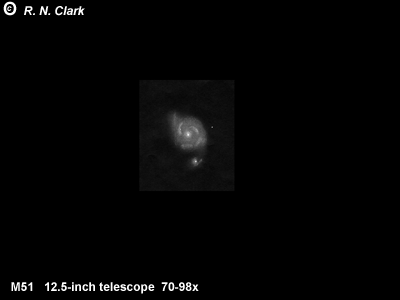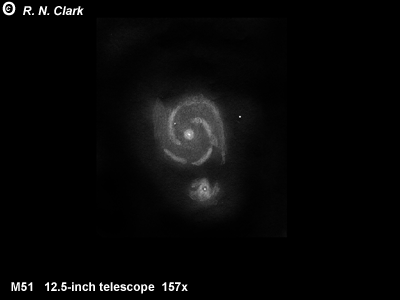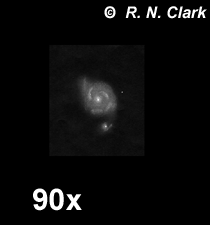ClarkVision.com
| Home | Galleries | Articles | Reviews | Best Gear | Science | New | About | Contact |
| Home | Galleries | Articles | Reviews | Best Gear | Science | New | About | Contact |
Introduction
Magnification can help you see detail in faint objects, like galaxies and nebulae, when viewed through your telescope. In my book Visual Astronomy of the Deep Sky, I show how the eye is more sensitive to fainter, lower contrast objects when they appear larger to your eye. As you increase the magnification of your telescope, an object increases in apparent size in the eyepiece in proportion to the magnification. But the surface brightness decreases because the light is spread out over a larger area. You can win up to a point. I'll illustrate the effect using drawings representing the view through a 12.5-inch telescope.
Figure 1 shows a low power view of the galaxy M51. While the spiral structure of M51 is apparent, no detail in the spiral arms can be seen. Faint outer portions of the galaxy can be detected.
 Figure 1
Figure 1 At medium power, Figure 2, we can seen more detail in the spiral arms, but the faintest outer portions of the galaxy are no longer seen.
 Figure 2
Figure 2 At high power, Figure 3, the larger fainter parts of the galaxy are no longer seen, but small detail in the spiral arms is visible. There is a small disk surrounding the central core that also can be detected, as are faint stars not seen at lower powers,
 Figure 3
Figure 3 If we put the views together from observations at all magnifications into one drawing (Figure 4), we see all the detail that I was able to detect during a 70-minute observation.
 Figure 4
Figure 4 How is this explained?
For each set of conditions, including the size and brightness of an object and the brightness of the background, there is an optimum magnification that magnifies that detail so it is easiest to detect by your eye. That optimum occurs when the object is magnified so that it appears about a degree or slightly more across. That detail may be the object itself, or something within the object, like a bright spot in a spiral arm. The small detail needs the highest magnification, and explains why the bright spots in the spiral arms in M51 were only seen at high magnifications.
 Figure 5
Figure 5
For more technical discussion of the magnification effects, see:
the Optimum Magnified Visual Angle (OMVA), for detecting the smallest, lowest contrast objects or detail within objects viewed through a telescope. Recent research and discussion about the concept, the confusion and controversies concerning the OMVA.
| Home | Galleries | Articles | Reviews | Best Gear | Science | New | About | Contact |
This page URL: http://clarkvision.com/astro/visastro/m51-mag/
Visual Astronomy main page at ClarkVision
Last updated April 9, 2002